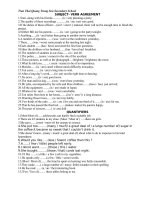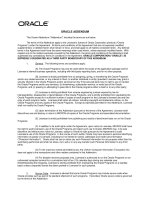Non-Disclosure and Confidentiality Agreement
Bạn đang xem bản rút gọn của tài liệu. Xem và tải ngay bản đầy đủ của tài liệu tại đây (188.64 KB, 33 trang )
Non-Disclosure and Confidentiality Agreement
The undersigned ("Recipient") hereby agrees that all financial and other information
("Information") that it has and will receive concerning Infrared Measuring Technologies is
confidential and will not be disclosed to any individual or entity without prior written consent.
The Information shall remain the property of Infrared Measuring Technologies and shall be
returned to Infrared Measuring Technologies promptly at its request together with all copies
made thereof.
Recipient acknowledges that no remedy of law may be adequate to compensate Infrared
Measuring Technologies for a violation of this Agreement and Recipient hereby agrees that in
addition to any legal or other rights that may be available in the event of a breach hereunder,
Infrared Measuring Technologies may seek equitable relief to enforce this Agreement in any
Court of competent jurisdiction.
_______________ ________________________________
Date Signature
This is a business plan and does not imply an offering of securities.
Infrared Measuring Technologies
Contact Information:
Jack Ball, President
Infrared Measuring Technologies, Inc.
1234 River Lane
Flint, MI 48501
(810) 555-1234
(810) 555-2345 Fax
This document contains confidential information. It is disclosed to you for informational
purposes only. Its contents shall remain the property of Infrared Measuring Technologies and
shall be returned to Infrared Measuring Technologies when requested.
This is a business plan and does not imply an offering of securities.
Table of Contents
1. Executive Summary 1
Business Opportunity
Products/Services Description
Current Business Position
Financial Potential
The Request
2. Company Background 4
Business Description
Company History
Current Position and Business Objectives
Ownership
3. Products 6
Product Overview
Competitive Analysis
Suppliers and Inventory
Research and Development
4. Services 8
Service Descriptions
Competitive Comparison
Service Delivery
Research and Development
5. The Industry, Competition and Market 9
Industry Definition
Primary Competitors
Market Size
Market Growth
Customer Profile
6. Marketing Plan 13
Competitive Advantage
Pricing
Distribution Channels
Promotional Plan
Feedback
7. Operating Plan 16
Location
Facility
Operating Equipment
Suppliers and Vendors
Personnel Plan
General Operations
8. Management, Organization and Ownership 19
Management/Principals
Organizational Structure
Professional Consultants
Ownership and Boards
9. Goals and Strategies 21
Business Goals
Keys to Success
Future Plans
10. Financial Assumptions 23
Beginning Balance Sheet
Profit & Loss
Balance Sheet
Cash Plan
11. Appendix 29
Beginning Balance Sheet
Profit & Loss (Years 1, 2, 3)
Balance Sheet (Years 1, 2, 3)
Cash Plan (Years 1, 2, 3)
Product Brochure
Customer Testimonials
Infrared Measuring Technologies 1
1. Executive Summary
Infrared Measuring Technologies, Inc. is ready to begin manufacturing and marketing an
exciting new product targeted to the custom-fitted clothing industry. This market has been
growing in the last several years, and the company’s new electronic scanning product will
provide retailers and customers alike a quick and easy way to measure customers for fitted
clothing. The company is in its start-up phase, but has already contracted 25 percent of its
first year's projected sales.
1.1 Business Opportunity
Infrared Measuring Technologies (IMT) manufactures and distributes a portable scanner
that analyzes and records body measurements for custom-fitted clothing. Several
main-line clothing manufacturers, such as Levi Straus, have started to offer
"made-to-order" clothing through traditional retailers. Upscale clothing manufacturers
have been offering custom-fitted clothing for many years.
The "SmartScanner" allows a retailer to accurately take a customer’s measurements
electronically and transmit them immediately to the manufacturer. This saves up to 90
percent of the time normally taken to record measurements, freeing the salesperson to
serve other customers. In addition, it saves the customer time and entices the retailers to
push higher margin custom clothes. The custom-fitted clothing market has grown from
0.05 percent of the U.S. retail clothing market to 0.10 percent in the last two years. This
200 percent increase translates into a $100 million market for custom-fitted clothing
manufacturers in 1998 and a terrific opportunity for IMT's product, the SmartScanner.
1.2 Products/Services Description
The SmartScanner is a hand-held, electronic, scanning device that utilizes an infrared
beam to record a customer’s clothing measurement information onto an integrated chip.
The salesperson scans the customer in three positions. For optimal results, the scanner
should be used in a fitting room with a bare white wall as a backdrop. The scanning
process takes only two minutes compared to an industry standard of twenty minutes for
hand measurement. IMT assembles the device at its plant in Michigan, relying on two
principal vendors for the chip and the infrared system. The company is targeting upscale
clothing retailers as the market for its first product. The scan is 100 percent accurate,
eliminating measuring errors made by hand, and ensures customer satisfaction with the
custom clothing. The company also plans to offer a maintenance agreement on the
SmartScanner, which guarantees its operation for as long as the maintenance agreement
is in effect.
1.3 Current Business Position
Jack Ball, a twenty-year veteran of the retail clothing industry, and Bill Jackson, an
engineer and seven-year veteran of the integrated chip industry, founded IMT as a C
Corporation in Michigan in 1997. It was capitalized with $150,000 in cash from the two
founders. The funds were used primarily for research and development of the
SmartScanner. Fifty prototypes have been made and were tested for six months in
Neiman Marcus retail stores across the U.S., an arrangement secured by Mr. Ball. The
Infrared Measuring Technologies 2
scanner received positive responses from customers, salespersons, and management.
The fifty prototype scanners were manufactured, assembled, and delivered to IMT at a
unit cost of $200. Neiman Marcus paid $500 rent per unit for the test period. With the
test proving successful, the company has agreed to purchase the prototype scanners for an
additional $500 per unit. Unit costs are expected to drop from $200 to $100 after
production is scaled up, and a final selling price of $750 is anticipated. Neiman Marcus
has signed an order to purchase an additional 250 units in the next year. Sales efforts are
currently underway with six major upscale department stores in the U.S. and Canada.
1.4 Financial Potential
IMT expects to generate $775,000 in revenues in year one, based on the sale of
approximately 1,000 scanners and 200 maintenance agreements. Sales are expected to
double in year two. Net income before taxes and interest is projected to be $25,000 in
year one and $267,000 in year two. The company expects to introduce a
second-generation scanner, to be named the "ValueScanner," in year three that will sell
for $500 and target lower-end department and apparel stores as the principal market.
Year three revenue projections are about $2.8 million in sales with a net income before
interest and taxes of almost $1.4 million.
Profit & Loss
For year beginning January, 2000
Sales Gross profit Oper. income Net income
$0
$500,000
$1,000,000
$1,500,000
$2,000,000
$2,500,000
$3,000,000
Year 1 Year 2 Year 3
1.5 The Request
IMT principals are willing to invest an additional $100,000 and are seeking funding of
$100,000 from an equity partner. Such an equity partner would enjoy minority
ownership, and IMT is willing to negotiate terms for a stock repurchase guarantee at the
end of five years.
These funds will be used for rent ($50,000), to upgrade space for operations ($25,000),
secure packaging and assembly equipment ($30,000), and provide funds for IMT's initial
marketing effort ($95,000).
Infrared Measuring Technologies 3
At the beginning of year two, IMT will require an operating loan of $100,000 to help
cover research and development expenses for the ValueScanner. IMT plans to secure this
amount as standard debt. Expected terms are a three-year loan at a 10 percent annual
interest rate.
Infrared Measuring Technologies 4
2. Company Background
The founders of the IMT have many years of experience in the retail clothing and electronics
industries. Jack Ball’s retail clothing experience provided the environment that led to his
realization that consumers desire a way to make purchasing custom-fitted clothing quick and
easy. Bill Jackson’s electronics experience enabled them to make a device that can meet this
need and exploit a previously unmet customer demand and market. With positive feedback
from several retailers, the founders decided to move forward with the concept. The two left
their former places of employment and started working on their concept in 1996.
2.1 Business Description
IMT is a C Corporation registered in Michigan that manufactures and markets scanners
for taking and recording body measurements. As an added service, IMT offers its
customers maintenance agreements that guarantee replacement of defective units. The
scanning devices will be marketed to clothing retailers, primarily upscale department
stores initially. The initial target market is the U.S. with future plans to expand into
Canada. Currently no other technologies exist that address this market, and IMT’s only
competition is the old, cumbersome hand method of taking measurements.
2.2 Company History
Although the principals began full-time development work on the product in 1996, IMT’s
structure was not formalized until the following year. Both principals live in Michigan
and established a C Corporation in that state in 1997. The company has completed the
necessary registration with the State of Michigan and with the IRS to enter full-scale
operations.
Jack Ball had the original concept for the scanner in 1996. He identified the need for such
a device by calling on clothing retail accounts for his former employer, Levi Straus,
where he served as national sales account manager for several years. After collecting
anecdotal information on the need for such a product, he left his employer in May 1996
to devote his efforts to developing the concept. Before concentrating his full-time effort
on the product, Mr. Ball consulted with his neighbor, Bill Jackson. Mr. Jackson was an
engineer for Acme Merchandising Systems (AMS) at the time, a company that
manufactures computer chips among other products. Mr. Jackson helped Mr. Ball by
identifying the electronics that would be required for the device and possible vendors
who could provide such items. In September 1996, Mr. Jackson left AMS and began
working full-time on the project.
A successful prototype had been made by the end of 1997. Throughout the months of
product development, the two founders put little capital into the business and drew no
personal salaries. The decision was made to move forward with testing the product and
the corporation was formed in late 1997. Mr. Ball and Mr. Jackson invested a total of
$150,000 at that time to fund the manufacturing of fifty prototypes, which could be tested
under actual retail conditions. By the beginning of 1998, the prototypes were ready and a
lease arrangement had been negotiated to test the scanners at several Neiman Marcus
locations throughout the Midwest.
Infrared Measuring Technologies 5
2.3 Current Position and Business Objectives
Currently, the company has completed the test phase of the scanners at the Neiman
Marcus sites. IMT received revenues of $25,000 from Neiman Marcus for leasing the
scanners during the test phase, and has secured a commitment from them to pay an
additional $25,000 to keep and use the scanners. This revenue, together with the
founders’ investment, have been able to cash flow the operations up to this point.
Research and development of the SmartScanner is complete, testing has been extremely
favorable, vendors for components are secured, and the product is ready to be
manufactured. IMT has moved to the start-up phase of its operations.
IMT’s mission statement follows:
"The goal of Infrared Measuring Technologies is to become the leader in the
manufacturing and marketing of electronic measuring devices for custom clothing
retailers. We will constantly strive to satisfy our customers’ needs and conduct our
business in a manner to produce financial returns that encourage and reward our
shareholders."
In the first several years, IMT will accomplish this mission with body-measurement
scanner products. The company expects to grow to almost $2.8 million in annual sales
revenues in its third year of operation. This will be achieved through the offering of two
different scanner products and a maintenance agreement.
2.4 Ownership
The principals, Jack Ball and Bill Jackson, are the sole stockholders in the company. The
company currently has no debt. A banking relationship has been established with the
First Bank of Michigan.
Infrared Measuring Technologies 6
3. Products
"The hand-held SmartScanner is the greatest thing to hit the custom-clothing market in the
last twenty years. The product saves our salespeople time and makes it quick and easy for
customers to purchase higher margin custom clothing." This quote is from Mary Smith,
Custom Clothing Manager for Neiman Marcus, who tested the SmartScanner for six months
in her store. IMT has received similar comments from other test participants. Additional
customer testimonials are included in the appendix.
3.1 Product Overview
The SmartScanner appears as a plastic box, 6" wide, 4" high, and 12" deep. The 6" by 4"
front of the device is clear, allowing an infrared beam to scan the area in front of the
device. The operating parts of the scanner are basically the infrared beam, a power
supply, and a microchip to analyze and record data. The device requires only one
operator, usually a customer service representative or salesperson. In order to use the
device, the customer stands before a white wall in three positions, i.e., facing front,
sideways, and back. The scanner is moved from the head to the foot of the customer in
each of the three positions. It is held at least two feet from the customer, so there is no
physical contact. The device detects the difference between the white background and the
contours of the customer, thereby determining body measurements.
The SmartScanner can measure a person in just a couple of minutes rather than the
twenty or more minutes required by a conventional tailor or salesperson. Both the
customer and the company save time. The information is encoded in the device and may
be immediately transmitted to the manufacturer for slotting in the next manufacturing run
of the clothing item. Ultimately, the customer receives the custom-fitted clothing he or
she has ordered, quickly and without the usual hassle. Each SmartScanner unit will be
priced at $750.
Below is a photograph of a customer being measured with a tape measure:
Infrared Measuring Technologies 7
3.2 Competitive Analysis
Currently, no direct competition exists for the SmartScanner. Up until now, a tailor or
salesperson had to take the customer’s measurements with a tape measure. For a modest
investment, a retailer can save around eighteen minutes of employee time on each
customer fitting. Competition from off-the-shelf, "sized" clothing is a consideration;
however, retailers have other incentives to drive customers to purchasing custom
clothing. Custom-fitted clothing usually delivers a higher margin, little or no money is
invested in inventory, and display space is opened for other goods. With the
SmartScanner, the retailer will satisfy customers’ needs and desires, and, at the same
time, achieve higher custom clothing sales and greater profits.
3.3 Suppliers and Inventory
The two major items incorporated into the product are the infrared system and the
integrated board that includes the computer chip. Smith Co. procures the chip,
manufactures the board, and provides the harness for the infrared system according to
IMT’s specifications. Jones Co. supplies the infrared scanning device to specifications
that allow integration with the board. Both of these companies are located in Michigan
and have solid track records. Mr. Jackson worked with both companies in his previous
position and developed a strong working relationship with them. IMT has a contract with
both Smith Co. and Jones Co. that guarantees a fixed number of units to be purchased in
a given year; however, these companies only ship and bill on demand. This allows for
minimum cash investment in inventory. Lead-time to assemble the scanners is minimal,
and sales orders are secured before assembling the product.
IMT receives its plastic casings from a local plastics company, Kelly, Inc. All of the
major assemblies are shipped to IMT’s facility where they are assembled into the finished
unit, packaged, and shipped.
3.4 Research and Development
The initial scanner, the SmartScanner, is being targeted to upscale department stores. The
scanner is priced at a premium, which allows IMT to maximize its gross margin.
Beginning in year two, a second-generation scanner will be researched and developed.
The work will be performed by IMT's current suppliers and their development teams.
This new ValueScanner will take advantage of feedback from the initial product and any
economies of scale discovered in the manufacturing process. It is expected to sell for
$500 per unit and have a 25 percent lower production cost than the SmartScanner. This
product will expand the target market as further explained in the marketing plan section.
Infrared Measuring Technologies 8
4. Services
The SmartScanner is a unique instrument with no similar products used in the apparel
industry. As such, there may be reluctance on the part of the retailers to purchase the
SmartScanner without a maintenance agreement. The company has tested the prototypes and
has experienced a zero failure rate to date. Yet, to foster customer confidence and
satisfaction, IMT will be offering a maintenance agreement that will give retailers the
assurance they desire and bring additional revenues into the business.
4.1 Service Descriptions
IMT will offer its customers an optional unlimited maintenance agreement that
guarantees the scanner will satisfactorily operate or be replaced at no charge. IMT will
charge an annual fee of $125 for this service. This pricing follows the industry standard
for an annual maintenance agreement of 18 percent of the item’s purchase price. The
standard warranty on the SmartScanner is ninety days. IMT expects that none of the units
will actually fail; however, if the unit should fail and it is covered by a maintenance
agreement, IMT will replace the product.
4.2 Competitive Comparison
No direct competitive products exist on the market today similar to the SmartScanner.
Other electronics companies that target clothing retailers offer maintenance agreements
so customers are familiar and accustomed to purchasing such add-ons. These companies
include those selling cash registers, time and attendance systems, and general office
equipment. This familiarity in the industry may foster customer interest in purchasing a
maintenance agreement for the SmartScanner.
4.3 Service Delivery
In order to service the SmartScanner units, the customer will contact the IMT service
center via a toll-free number. The IMT representative will ensure the unit is either
covered under warranty or a maintenance agreement. If covered, the customer will
identify the serial number on the failed scanner, IMT will authorize its return, and a new
scanner will be sent to the customer immediately. IMT expects that no customer will go
longer than two days from reporting a problem to receiving a replacement scanner. If the
unit is not covered by either warranty or maintenance agreement, the retailer is charged
for repairs made to the SmartScanner unit and runs the risk of not having a functioning
unit until the repairs have been made. The IMT service center is located in the assembly
plant.
4.4 Research and Development
IMT is planning to research and develop a second-generation scanner, the ValueScanner,
in year two. The maintenance agreement will be used as a quality control tool and to
measure customer satisfaction. It will be a residual profit center for IMT. The failure rate
of the SmartScanner will be tracked and used to determine warranty policy. Also, if the
SmartScanner maintenance agreement program is successful, IMT will offer a
comparable maintenance agreement to ValueScanner owners.
Infrared Measuring Technologies 9
5. The Industry, Competition and Market
The economic boom of the late 1990’s was strongly driven by consumer spending. Part of
this boom has been felt in the apparel industry, and with rising incomes, it is expected to
continue. Sales of custom-fit clothing are increasing, and the SmartScanner can help retailers
capitalize on this high-profit market. The following sections discuss the opportunities for the
scanner in light of no competition and growing consumer demand for custom clothing.
5.1 Industry Definition
IMT's core products will be electronic measuring devices. Although the industry for such
instruments is diverse and filled with competitors, the company will not compete in this
arena. The true industry that is relevant to IMT is the retail consumer apparel industry.
This industry encompasses clothing stores (North American Industry Classification
System [NAICS] #4481), and department stores (NAICS #452110). There are other
classifications for apparel outlets, e.g., on the Internet, but these are not viable markets
for IMT’s products which requires customer contact.
Technological advances are creating the opportunity for clothing manufacturers to
manufacture and provide apparel in custom sizes on a short-notice basis. Clothing
retailers and department stores are taking advantage of this to sell higher-profit,
custom-fitted clothing to customers. According to the U.S. Department of Commerce,
sales of custom-fit clothing have increased from 0.05 percent of the U.S. clothing market
to 0.10 percent in the last two years -- an increase of 200 percent. Johnson & Co., a
market research firm specializing in retail clothing stores, projects that U.S. custom-fit
apparel sales will increase an average of 20 percent each year over the next five years.
With such projected growth, retailers in the industry stand to benefit from utilizing IMT's
products.
5.2 Primary Competitors
The SmartScanner has no direct competitors. Historically, custom clothing measurements
have been taken with a tape measure by a salesperson. For catalog and online clothiers,
the consumer takes his or her own measurements. Since the SmartScanner is being
targeted to upscale department stores, catalog and websites sales are only indirect
competitors to our target market, not to the scanner itself.









